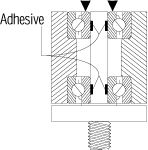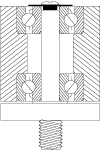 1.
Deadweight: A fixed weight is set against the
bearing ring while adhesive cures to retain the bearings. This
system is used in many applications, and gives well-controlled
torque values as well as maximum stiffness. Disadvantages are
cure time and special handling of adhesive in mass-production.
Care must be taken to allow for relative thermal expansion effects
if different materials are used in mating parts.
1.
Deadweight: A fixed weight is set against the
bearing ring while adhesive cures to retain the bearings. This
system is used in many applications, and gives well-controlled
torque values as well as maximum stiffness. Disadvantages are
cure time and special handling of adhesive in mass-production.
Care must be taken to allow for relative thermal expansion effects
if different materials are used in mating parts.

 2. Spring: Spring is used to press inner rings
together or outer races apart. This system is easy to assemble,
but has minimal stiffness since the spring can move after assembly
so that the stiffness of the final assembly is controlled by
the spring rate rather than the raceway-ball elasticity. Thermal
effects from relative expansions of mating parts are minimized.
Spring preload is often used in high speed applications.
2. Spring: Spring is used to press inner rings
together or outer races apart. This system is easy to assemble,
but has minimal stiffness since the spring can move after assembly
so that the stiffness of the final assembly is controlled by
the spring rate rather than the raceway-ball elasticity. Thermal
effects from relative expansions of mating parts are minimized.
Spring preload is often used in high speed applications.
Note: For Belleville or wavy-washer
springs the tolerance stack up of mating parts can give a variation
in spring compression that is a large percentage of the maximum
allowable compression of the spring. This means that the preload
can vary greatly unless a spring with a low spring rate is used
(can be difficult to find).
 3.
Solid clamping: Component parts are machined
to precise dimensions to remove axial play when the races are
clamped together. In theory, is easy to assembly has few components
and good stiffness. However, due to the natural range of the
bearing axial play, it is difficult to achieve in practice.
Unless components and bearings are matched to a very high precision
the resulting assembly may be damaged through raceway brinelling
or may not have adequate preload
3.
Solid clamping: Component parts are machined
to precise dimensions to remove axial play when the races are
clamped together. In theory, is easy to assembly has few components
and good stiffness. However, due to the natural range of the
bearing axial play, it is difficult to achieve in practice.
Unless components and bearings are matched to a very high precision
the resulting assembly may be damaged through raceway brinelling
or may not have adequate preload
Note: precision matched bearing
pairs are available as Duplex Pair Bearings, but these are significantly
more expensive than standard bearings).

 1.
Deadweight: A fixed weight is set against the
bearing ring while adhesive cures to retain the bearings. This
system is used in many applications, and gives well-controlled
torque values as well as maximum stiffness. Disadvantages are
cure time and special handling of adhesive in mass-production.
Care must be taken to allow for relative thermal expansion effects
if different materials are used in mating parts.
1.
Deadweight: A fixed weight is set against the
bearing ring while adhesive cures to retain the bearings. This
system is used in many applications, and gives well-controlled
torque values as well as maximum stiffness. Disadvantages are
cure time and special handling of adhesive in mass-production.
Care must be taken to allow for relative thermal expansion effects
if different materials are used in mating parts.
 2. Spring: Spring is used to press inner rings
together or outer races apart. This system is easy to assemble,
but has minimal stiffness since the spring can move after assembly
so that the stiffness of the final assembly is controlled by
the spring rate rather than the raceway-ball elasticity. Thermal
effects from relative expansions of mating parts are minimized.
Spring preload is often used in high speed applications.
2. Spring: Spring is used to press inner rings
together or outer races apart. This system is easy to assemble,
but has minimal stiffness since the spring can move after assembly
so that the stiffness of the final assembly is controlled by
the spring rate rather than the raceway-ball elasticity. Thermal
effects from relative expansions of mating parts are minimized.
Spring preload is often used in high speed applications.